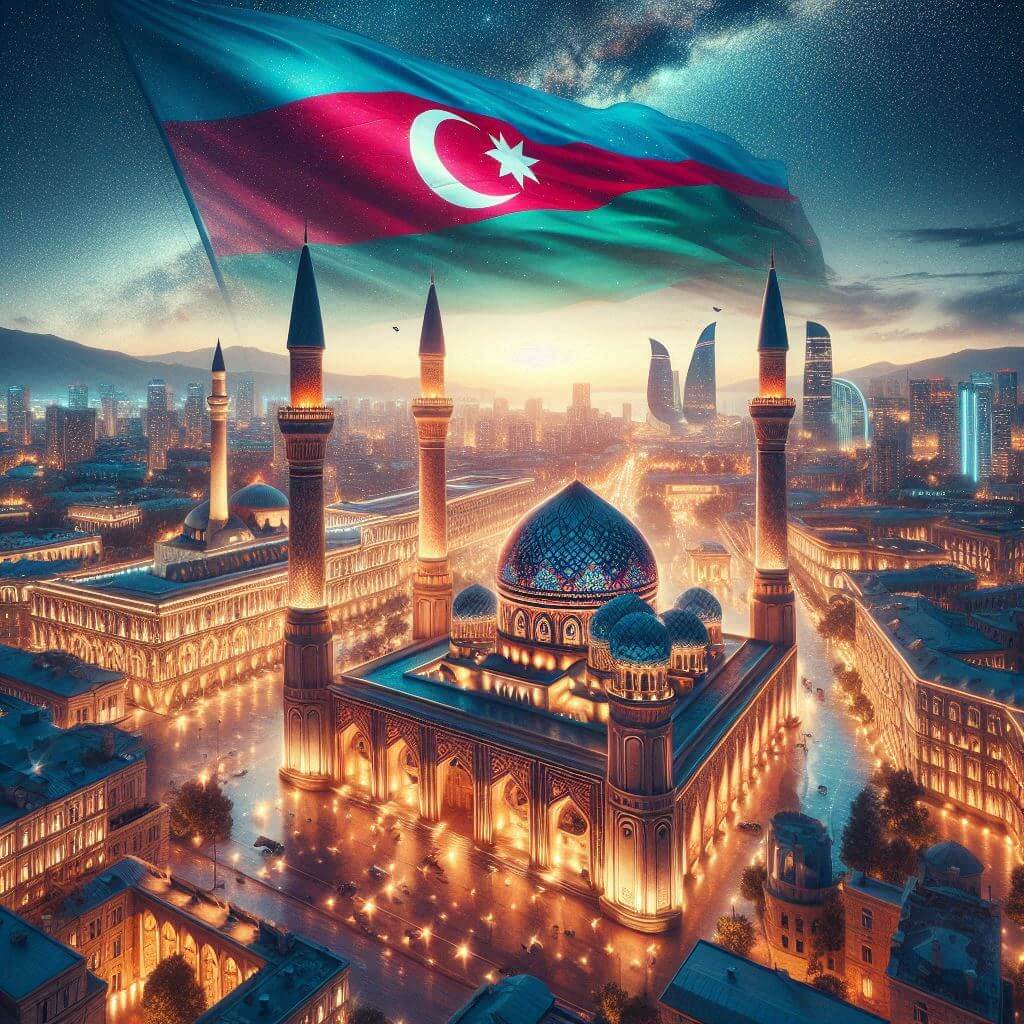The flag of Azerbaijan consists of three horizontal stripes of blue, red, and green, with a white crescent and an eight-pointed star centered in the red stripe. This vibrant design encapsulates the nation's rich history, cultural heritage, and aspirations for the future.
Azerbaijan information
| National Flag Day | November 9th |
| Sovereign state | Yes |
| Official name | Republic of Azerbaijan |
| Capital | Baku |
| Population | 10,234,172 |
| Area | 86,600 km² |
| Currency | Azerbaijani manat (AZN) |
| Language | Azerbaijani |
| Continent | Asia |
| Region | Western Asia |
| Subregion | South Caucasus |
| Borders | Armenia, Georgia, Iran, Russia, Turkey |
| Timezone | Azerbaijan Time (AZT) UTC+4 |
| Calling code | +994 |
| Top-level domain | .az |
History of the Azerbaijani Flag
 The current flag of Azerbaijan was officially adopted on February 5, 1991, following the country's independence from the Soviet Union. However, its origins trace back to the early 20th century. The flag was first used by the Azerbaijan Democratic Republic (ADR) from 1918 to 1920, during a brief period of independence before Soviet annexation.
The current flag of Azerbaijan was officially adopted on February 5, 1991, following the country's independence from the Soviet Union. However, its origins trace back to the early 20th century. The flag was first used by the Azerbaijan Democratic Republic (ADR) from 1918 to 1920, during a brief period of independence before Soviet annexation.
During the Soviet era, Azerbaijan used a modified version of the Soviet flag. The resurgence of the tricolor flag in 1991 symbolized a return to national identity and independence, connecting modern Azerbaijan with its pre-Soviet democratic traditions.
Symbolism and Design of the Azerbaijani Flag
Each element of the Azerbaijani flag holds deep significance:
- The blue stripe signifies Azerbaijan's Turkic heritage and the cultural unity of Turkic-speaking peoples.
- The red stripe symbolizes progress, modernization, and the development of democracy.
- The green stripe represents the nation's connection to Islam, a fundamental aspect of Azerbaijani culture and identity.
- The white crescent is a traditional symbol of Islam, also representing progress and a bright future.
- The eight-pointed star, also white, is known as the Star of Azerbaijan. Its points represent the eight branches of the Turkic peoples.
Evolution and Continuity
 The flag's design has remained largely unchanged since its first adoption by the ADR in 1918. This continuity reflects Azerbaijan's enduring national identity despite periods of foreign rule. The eight-pointed star, a symbol with deep roots in the region's history, was featured in various historical Azerbaijani and Turkic emblems long before its incorporation into the national flag.
The flag's design has remained largely unchanged since its first adoption by the ADR in 1918. This continuity reflects Azerbaijan's enduring national identity despite periods of foreign rule. The eight-pointed star, a symbol with deep roots in the region's history, was featured in various historical Azerbaijani and Turkic emblems long before its incorporation into the national flag.
Usage and Significance of the Azerbaijani Flag
The flag of Azerbaijan is a powerful symbol of national pride, unity, and independence. It is prominently displayed on government buildings, schools, and public institutions. During national holidays, particularly on State Flag Day (November 9th) and Independence Day (October 18th), the flag takes center stage in celebrations across the country.
In international contexts, the Azerbaijani flag represents the nation at diplomatic events, United Nations gatherings, and global sporting competitions. It serves as a visual ambassador, instantly recognizable and respected worldwide.
Interesting Facts About the Azerbaijani Flag
- The world's largest Azerbaijani flag, measuring 70 by 35 meters, flies on a 162-meter flagpole in Baku, the capital city.
- The flag's colors are sometimes interpreted as representing fire (red), referring to Azerbaijan's nickname "The Land of Fire" due to its natural gas reserves.
- The eight-pointed star is also associated with eight letters in the word "Azerbaijan" when written in the old Arabic script.
- During the Soviet era, variations of the tricolor design were used by Azerbaijani expatriate communities as a symbol of independence aspirations.
- The flag's proportions are 1:2, meaning its width is half its length, a common ratio for national flags.